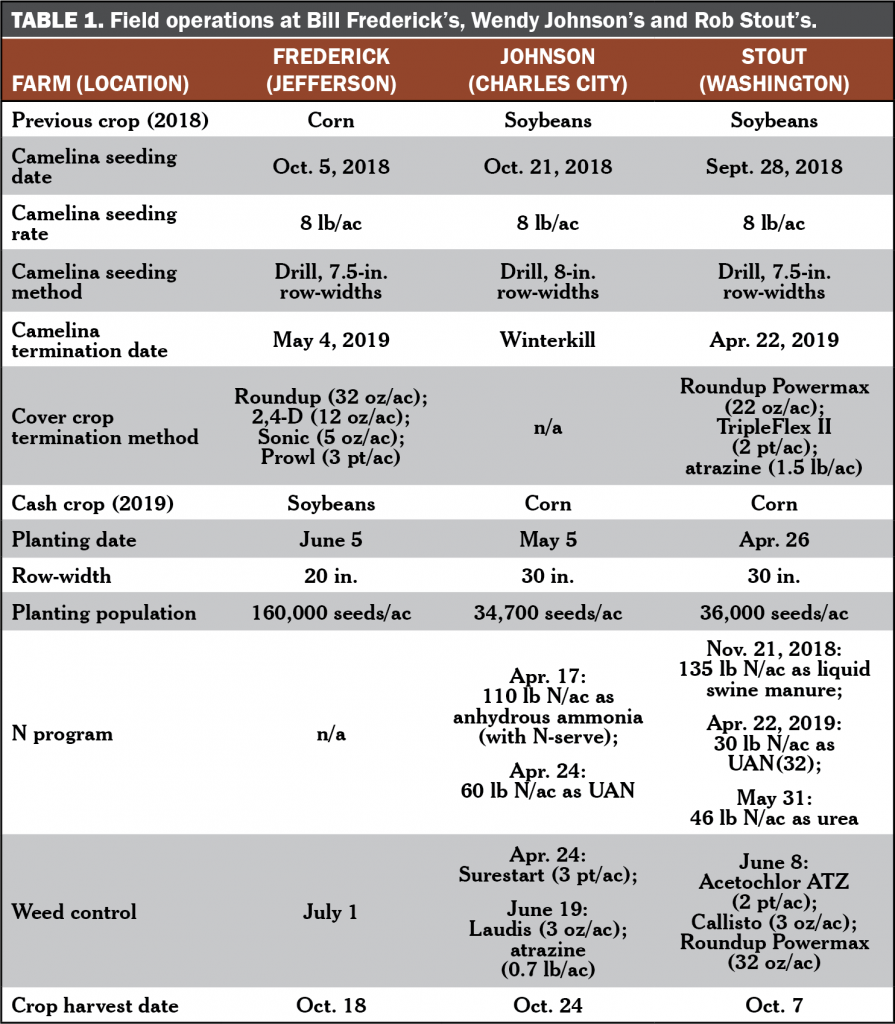This project was supported by Dr. Andy Lenssen, Iowa State University Department of Agronomy.
In a Nutshell:
- Winter cover crops in corn-soybean production systems in Iowa are mostly limited to small-grains species like cereal rye or winter wheat because of their ability to successfully overwinter when seeded in early fall.
- Bill Frederick, Wendy Johnson and Rob Stout seeded strips of camelina, a winter-hardy brassica species, to determine its ability to overwinter and any effect on corn and soybean yields.
Key Findings:
- The camelina cover crop successfully overwintered at Frederick’s and Stout’s but suffered winterkill at Johnson’s.
- Soybean and corn yields were not affected by the camelina cover crop.
Background
Winter cover crops in Iowa corn-soybean systems are mostly limited to small-grains species like cereal rye or winter wheat because of their abilities to 1) germinate under soil temperatures occurring near or after corn and soybean harvest in the fall; and 2) overwinter to the following spring.[1] Cover crop variety trials conducted by PFI cooperators from 2013-2017 bear this out: Cereal rye, winter wheat and winter triticale routinely out-performed brassica and legume species in terms of fall and spring groundcover when overseeded into standing corn and soybeans in early fall.[2–5]
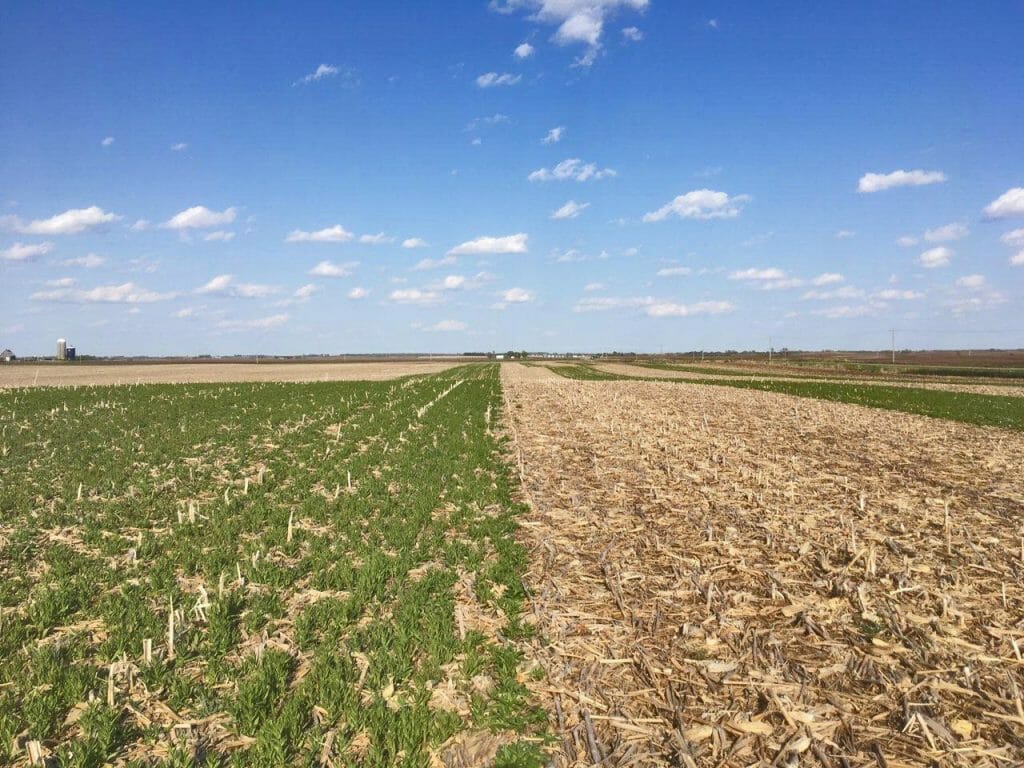
Strips of camelina cover crop and no cover crop at Bill Frederick’s farm near Jefferson on May 4, 2019. The camelina was seeded Oct. 5, 2018.
Even so, farmers who have used cereal rye cover crops for over five years have begun to express interest in finding alternative, successful, non-small-grains cover crops for corn-soybean production systems. Dr. Andy Lenssen, professor of agronomy at Iowa State University, has recently been experimenting with camelina, a winter-hardy brassica species that has shown promise as a cover crop in experiments conducted on university research stations. In 2018, Dr. Lenssen presented an opportunity for PFI cooperators to try camelina as a cover crop on their farms. He offered the seed and in exchange the cooperators planted strips of camelina following corn or soybean harvest.
“I am interested in finding different cover crop species that will help my succeeding corn crop perform better than following a cereal rye cover crop,” Rob Stout said about his motivation for conducting this trial. “I’ve wanted to see camelina in action for a couple years,” Bill Frederick said. Wendy Johnson echoed both Stout’s and Frederick’s sentiments: “I am interested in alternative crops and cover crops to use in Iowa. Depending on this trial’s data, we might use camelina on our farm.”
Methods
Design
All three cooperators seeded a camelina cover crop in Fall 2018 with seed provided by Dr. Andy Lenssen, Iowa State University Department of Agronomy. Frederick seeded the camelina into corn residue; Johnson and Stout seeded into soybean residue. Cover crop and crop management details for each farm are provided in Table 1.
To test the effect of the camelina cover crop on cash crop yield, each cooperator compared two treatments:
- Camelina cover crop
- No-cover-crop (control)
Each cooperator implemented at least four replications of the two treatments in randomized strips (Figure A1). Strips at each farm were as wide as at least one combine pass and ran the length of the field.
Measurements
After the camelina emerged from the soil, Dr. Lenssen travelled to each farm to determine stand densities within one month of the seeding dates. This occurred on Oct. 17, 2018 at Frederick’s; Nov. 8, 2018 at Johnson’s; and Oct. 18, 2018 at Stout’s. The following spring, each farmer estimated the height of the camelina prior to termination and cash crop planting. In Fall 2019, the cooperators harvested the cash crop from each individual strip; corn was corrected to 15.5% moisture and soybeans were corrected to 13% moisture.
Data analysis
To evaluate any effects of the camelina cover crop on crop yield, we calculated the least significant difference (LSD) using a t-test. If the difference in yield resulting from the two treatments was greater than or equal to the LSD, we considered this a statistically significant effect. On the other hand, if the difference resulting from the two treatments was less than the LSD, we considered the treatments to be statistically similar. We used a 90% confidence level to calculate the LSDs, which means that we would expect our findings to occur 9 times out of 10. We could make these statistical calculations because the cooperators’ experimental designs involved replication and randomization of the camelina cover crop and no-cover-crop treatments (Figure A1).
Results and Discussion
Cover crop stand densities in fall
Camelina stands in Fall 2018 varied in terms of average stands and the evenness of the stands. Average stand at Frederick’s was 260,000 plants per acre; at Johnson’s was 302,500 plants per acre; and at Stout’s was 777,000 plants per acre. All farms seeded the camelina at the same rate: 8 lb/ac.
Cover crop height in spring
The camelina was roughly 6 in. tall at Frederick’s on May 4, 2019 prior to chemical termination and subsequent soybean planting. At Stout’s, the camelina was roughly 11 in. tall on Apr. 24, 2019 prior to chemical termination and subsequent corn planting (see photos). The camelina did not successfully overwinter at Johnson’s (the most northern location of all farms involved). “We had cold rain and freezing conditions during much of November [after the camelina germinated]. We didn’t get snow cover until mid-January [2019],” Johnson said. Dr. Andy Lenssen, who collaborated on this project, reported that camelina has survived winters in experimental plots in central, southwest and northwest Iowa: “Snow cover seems to become important when temperatures get colder than -20° F, especially if seedlings were exposed to comparatively warm conditions that caused some loss of dormancy.”
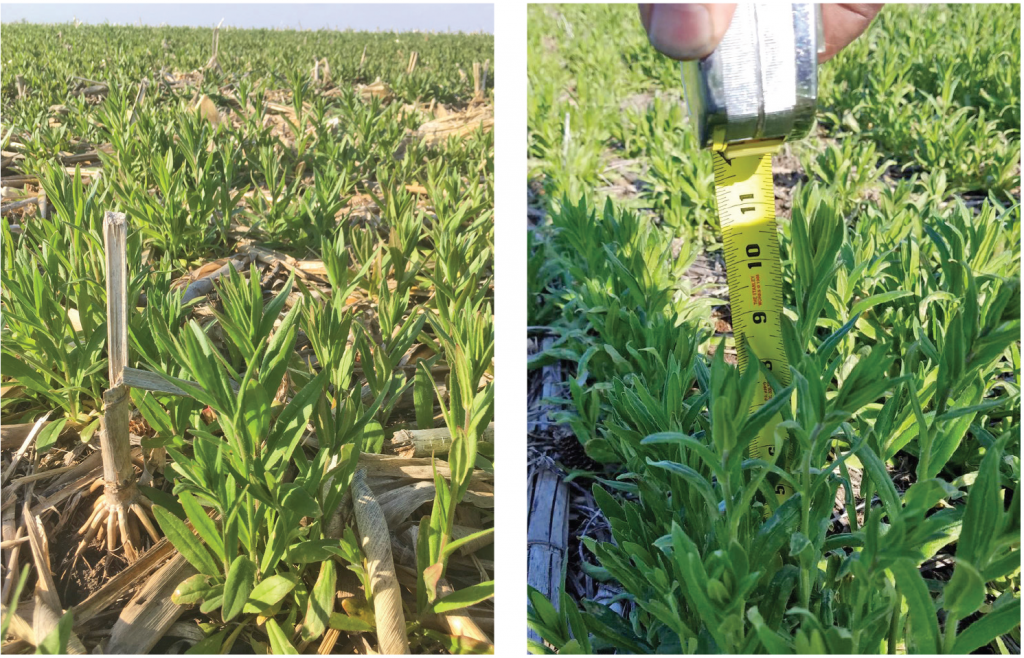
At left, the camelina cover crop at Bill Frederick’s on May 4, 2019. On the right, the camelina cover crop at Rob Stout’s on Apr. 24, 2019.
Crop yields
Compared to the no-cover-crop control, the camelina cover crop had no effect on soybean yield at Frederick’s nor did it have any effect on corn yields at Johnson’s or Stout’s (Figure 1).
Soybean yields at Frederick’s and corn yields at Stout’s far exceeded their respective five-year county averages of 57 bu/ac and 207 bu/ac.[6] Corn yields at Johnson’s fell below the five-year Floyd County average of 189 bu/ac.[6]
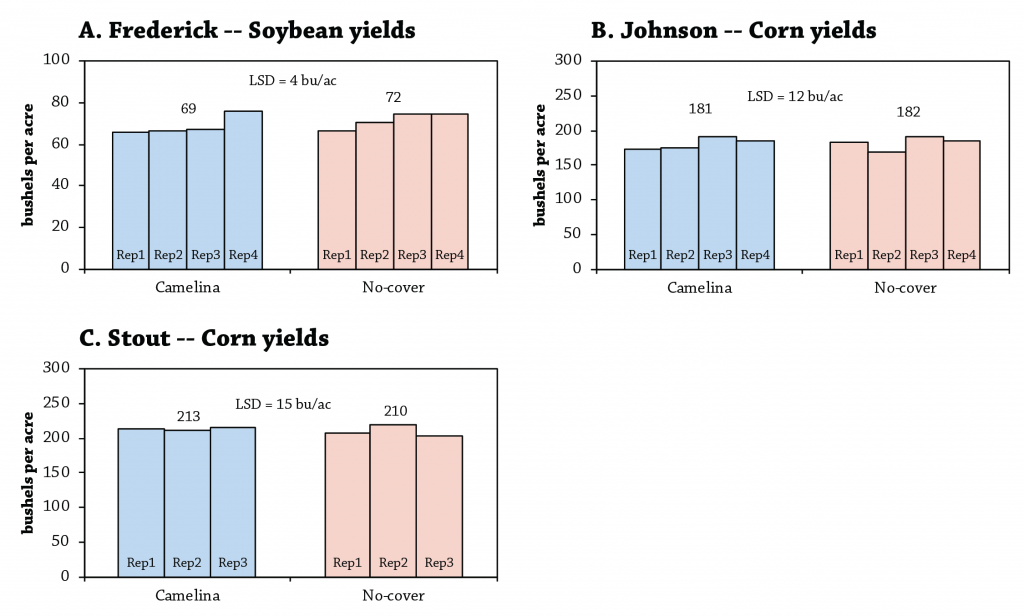
Figure 1. Crop yields at A) Frederick’s; B) Johnson’s; and C) Stout’s. Columns represent individual strip values. Above each set of columns is the treatment mean. By farm, because the difference between the treatment means is less than the least significant difference (LSD), the treatments are considered statistically similar at the 90% confidence level. Click to enlarge.
Conclusions and Next Steps
Across the three farms, the camelina cover crop had no effect on soybean or corn yields. This is an important finding that echoes the results of a long-term on-farm project coordinated by Iowa Learning Farms and PFI. The cereal rye cover crop in that study had a mostly neutral effect on corn and soybean yields.[7] It is also important for those who might desire diversifying their fall-sown cover crops instead of solely relying on cereal rye. “I think camelina has a lot of potential as a cover crop,” Bill Frederick said. “Low seeding rates because of its small seed size will lower application costs.” The camelina successfully overwintered on Frederick’s farm near Jefferson in west-central Iowa. Though, because the camelina cover crop failed to overwinter at one farm in this trial (Wendy Johnson’s near Charles City), more work on best management practices should probably be conducted before broader adoption of camelina as a cover crop in Iowa.
Appendix – Trial Design and Weather Conditions
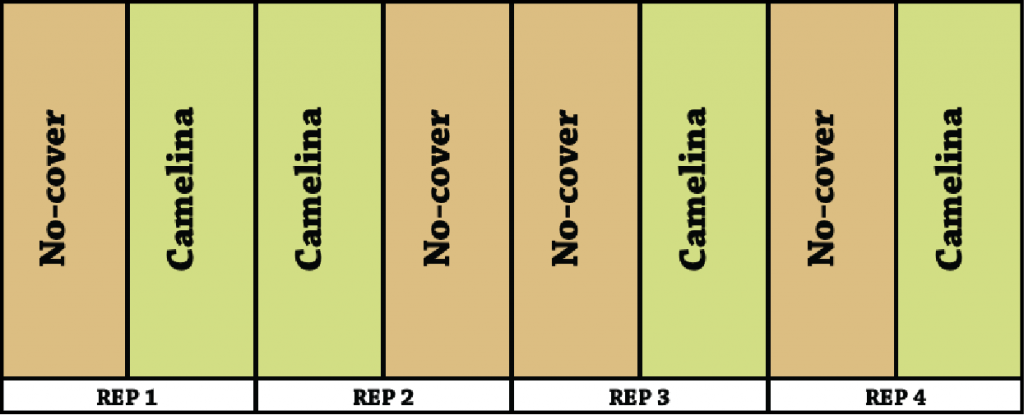
Figure A1. Sample experimental design used by the cooperators. The design includes randomized replications of the camelina cover crop and no-cover-crop treatments. This design allowed for statistical analysis of the results. Click to enlarge.
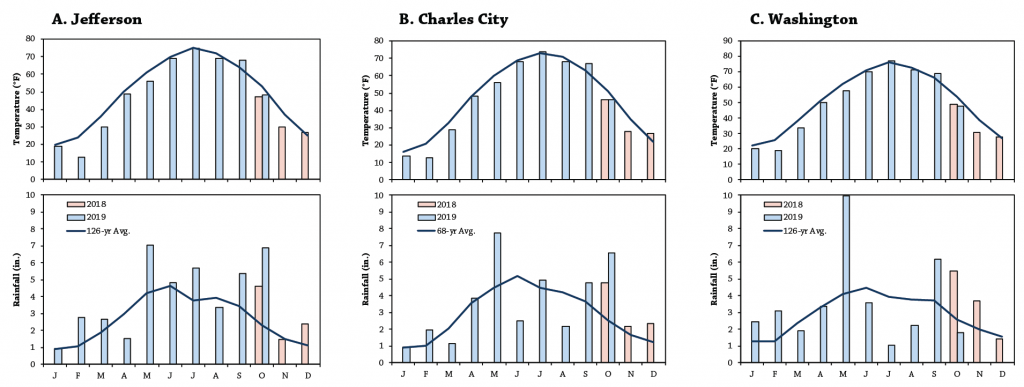
Figure A2. Mean monthly temperature and rainfall for Oct. 1, 2018 through Oct. 31, 2019 and the long-term averages at the nearest weather stations to each farm.[8] A) Jefferson (Frederick); B) Charles City (Johnson); C) Washington (Stout). Click to enlarge.
References
- Cates, A.M., G.R. Sanford, L.W. Good and R.D. Jackson. 2018. What do we know about cover crop efficacy in the North Central United States? Journal of Soil and Water Conservation. 73:153A-157A. http://www.jswconline.org/content/73/6/153A.short (accessed January 2020).
- Gailans, S., J. Gustafson, C. Ingels, C. Mcgrath, M. Peterson, M. Rees, B. Schrader and P. Kassel. 2017. Cover Crop Variety Trial 2016-2017. Practical Farmers of Iowa Cooperators’ Program. https://practicalfarmers.org/research/cover-crop-variety-trial-2016-2017/ (accessed January 2020).
- Gailans, S., J. Gustafson, C. Ingels, C. Mcgrath, M. Peterson, M. Rees, D.& M. Schmidt, B. Schrader and N. Williamsen. 2016. Cover Crop Variety Trial 2015-2016. Practical Farmers of Iowa Cooperators’ Program. https://practicalfarmers.org/research/cover-crop-variety-trial-2015-2016/ (accessed January 2020).
- Gailans, S., J. Gustafson, P. Kassel, C. Mcgrath, M. Peterson and D.& M. Schmidt. 2015. Cover Crop Variety Trial 2014-2015. Practical Farmers of Iowa Cooperators’ Program. https://practicalfarmers.org/research/cover-crop-variety-trial-2014-2015/ (accessed January 2020).
- Gailans, S., J. Depew, J. Gustafson, C. Ingels, C. Mcgrath, S. Mcgrew, M. Peterson, M. Rees and D.& M. Schmidt. 2013. Cover Crop Variety Trial 2013-2014. Practical Farmers of Iowa Cooperators’ Program. https://practicalfarmers.org/research/cover-crop-variety-trial/ (accessed January 2020).
- US Department of Agriculture-National Agricultural Statistics Service. Quick stats. USDA-National Agricultural Statistics Service. https://quickstats.nass.usda.gov/ (accessed January 2020).
- Gailans, S. and L. Juchems. 2019. Winter Cereal Rye Cover Crop Effect on Cash Crop Yield. Practical Farmers of Iowa Cooperators’ Program and Iowa Learning Farms. https://practicalfarmers.org/research/winter-cereal-rye-cover-crop-effect-on-cash-crop-yield-4/ (accessed January 2020).
- Iowa Environmental Mesonet. 2019. Climodat Reports. Iowa State University. http://mesonet.agron.iastate.edu/climodat/ (accessed January 2020).


